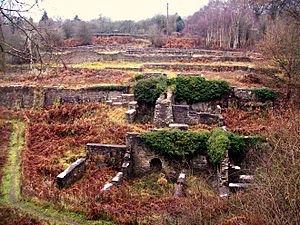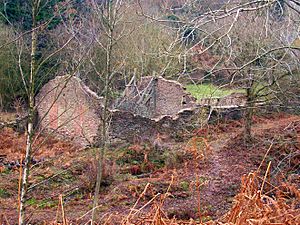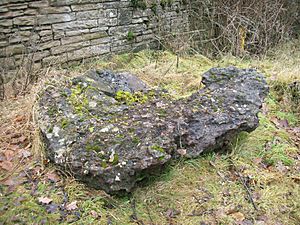Darkhill Ironworks facts for kids
Quick facts for kids Darkhill Ironworks |
|
|---|---|

Remains in 2007
|
|
| Location | Gloucestershire, England, UK |
| OS grid reference | SO587085 |
| Lua error in Module:Location_map at line 420: attempt to index field 'wikibase' (a nil value). | |
Darkhill Ironworks and the nearby Titanic Steelworks are super important historical sites. They show us how the iron and steel industries grew. Both places are protected as scheduled monuments, which means they are important historical sites. You can find them near a small village called Gorsty Knoll, close to Parkend in the Forest of Dean, Gloucestershire. Sometimes, people used to write 'Dark Hill' instead of 'Darkhill'.
Contents
Darkhill Ironworks: A Place of Big Ideas
The Start of Something New
A smart scientist from Scotland, named David Mushet, came to the Forest of Dean in 1810. He was a metallurgist, which means he studied how metals work. He first managed another ironworks, but then started his own project.
Around 1818, David built an experimental furnace at Darkhill. This furnace used coke as fuel. This was the beginning of industrial work at Darkhill. He made a lot of iron there, but he mostly used the site for experiments. He wanted to learn new things about making iron.
Robert Mushet's Amazing Experiments
In 1845, David Mushet retired. He gave Darkhill to his three sons. His youngest son, Robert Mushet, became the manager. The brothers didn't always get along. After their father passed away, they tried to sell Darkhill.
But Robert, now on his own, teamed up with a merchant named Thomas Deykin Clare. In 1848, they opened a small experimental steelworks at Darkhill. They called it the Forest Steel Works.
Robert made some steel and tools here. But more importantly, he did many experiments with different types of steel. He worked on making new steel alloys. An alloy is a mix of metals. He realized he needed a bigger place for his new ideas.
The Titanic Steelworks Story
Robert Mushet was very excited about an alloy using Titanium. So, he named his new company The Titanic Steelworks. It opened in October 1862. It was less than 250 yards from the old Darkhill works.
Three hundred people worked there. But the new alloys didn't sell as well as hoped. Robert went back to his experiments. In 1868, he invented something amazing: 'R Mushet's Special Steel' (R.M.S.).
In 1870, Robert met Samuel Osborn. He was a steelmaker from Sheffield. Osborn convinced Robert that the future of steel was in Sheffield. So, in 1871, the Titanic works closed down.
Robert made a deal with Samuel Osborn. Osborn got the only right to make R.M.S. Robert would get money for every ton sold. To keep the special process a secret, some steps were still done in the Forest of Dean. Robert Mushet himself watched over this. His two sons moved to Sheffield to help with manufacturing. Samuel Osborn & Company became a huge steel company.
The Titanic company officially closed in 1874. Many of its buildings were later removed. Some materials were even used to help build the Severn Bridge.
Darkhill Ironworks was sold by the brothers in 1864. Later, a railway company owned it. In 1981, Darkhill was sold back to the Crown.
Why Darkhill and Titanic Matter
The first coke-fired furnace was built in 1709. But it took a long time for them to appear in the Forest of Dean. The Forest had lots of iron-ore and coal. But the local coal didn't make the best coke for smelting.
Around 1820, Moses Teague found a way to make good iron from local coke. He used a furnace at Darkhill Ironworks to figure this out. This discovery helped the iron industry in the Forest of Dean grow a lot.
David Mushet started everything at Darkhill. His work set the stage for his son Robert's achievements. Both men loved to experiment. Robert did over ten thousand experiments in just ten years! He got 54 patents for his work. But he didn't always get the money or fame he deserved.
Robert Mushet helped improve the Bessemer Process in 1856. This process was a big step in making steel. Mushet found a way to fix problems with early steel quality. He patented his method, but the patent ran out. Even though Bessemer later claimed to find the same solution, Mushet's method was used everywhere.
In 1857, the first steel railway lines were made at Darkhill. They were used near Derby railway station. Iron rails there had to be replaced every few months. But Robert Mushet's new steel rails showed no wear after ten years! He wanted them back when they were done, but they were scrapped.
In 1868, Robert invented 'R Mushet's Special Steel' (R.M.S.). This was the first true tool steel. It was also the first air-hardening steel. This meant it got hard just by cooling in the air. This invention changed how machine tools were designed. It was a big step for metalworking. It also led to High speed steel.
Darkhill Ironworks and the Titanic Steelworks became protected sites in 2002. The protected area includes an old tram-road and a large lump of clinker. Today, these sites are preserved as important historical places. They are open for everyone to visit and learn from.
Images for kids






